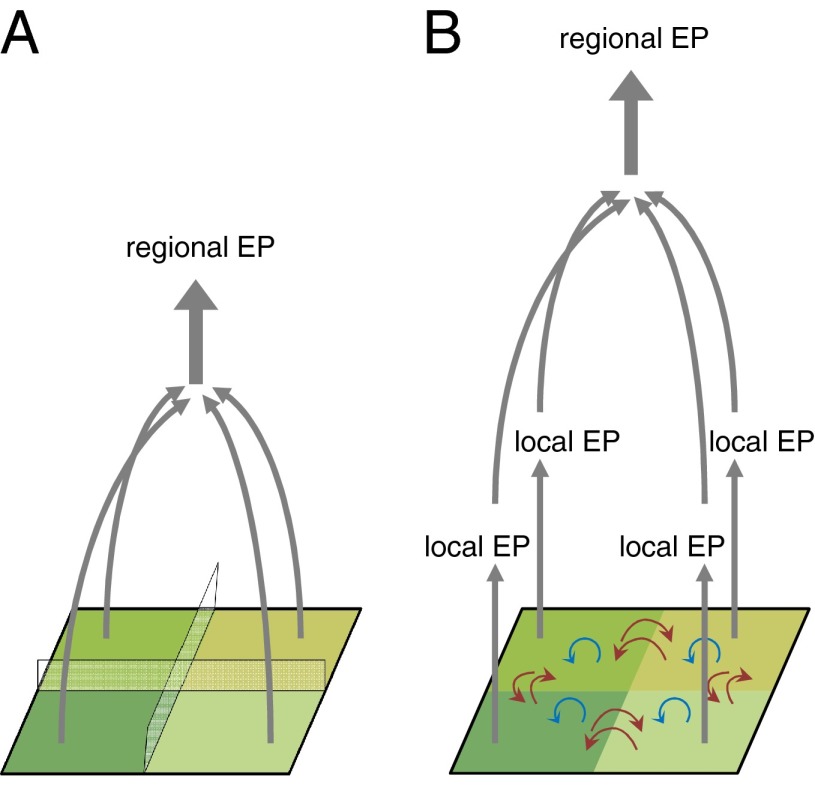Pasari et al. (1) provide a valuable fresh perspective on the role of biodiversity in influencing ecosystem processes. Importantly, they move beyond the traditional focus on local diversity (α diversity) and highlight the potential importance of biodiversity at larger scales (β diversity and γ diversity) in influencing important ecosystem processes. Despite this unique perspective, their analysis does not consider several important mechanisms by which β diversity could affect ecosystem processes. We highlight important limitations in the analyses by Pasari et al. (1) and illustrate how these could be overcome through unique combinations of macroscale spatial analyses and ecological modeling.
Pasari et al. (1) assembled virtual metacommunities by combining 24 randomly selected communities from diversity treatments of the Biodiversity II experiment, then assessed the relationship between β diversity and aggregate ecosystem processes across the component communities (Fig. 1A). This aspatial approach eliminates the most important mechanisms by which β diversity could influence ecosystem processes. In natural regions, compositional differences between interacting communities enable new species with different physiological responses to disperse between communities as environmental conditions change (Fig. 1B). This temporal turnover in community composition is likely to be strongly influenced by the spatial β diversity of the metacommunity in which it resides. Thus, temporal turnover is likely to have important implications for ecosystem processes at both local and regional scales (Fig. 1B). In this way, the β diversity of a region may provide “insurance” or “portfolio” effects at the metacommunity scale, potentially influencing both local and regional ecosystem processes. The approach of Pasari et al. (1) effectively generates regional estimates of β-effects on regional ecosystem processes in the absence of these important interactions between and within local communities (Fig. 1). This aspect may partially explain the relatively weak effects of β diversity on ecosystem processes observed by Pasari et al. (1).
Fig. 1.
(A) The approach of Pasari et al. (1) estimates the effect of β diversity on regional ecosystem processes (EP) by averaging the values for all communities independently. (B) Alternative approaches could account for the important within (blue arrows) and between (red arrows) community processes through which β diversity may influence ecosystem processes at both local and regional scales.
Analyzing communities independent of their location in geographic or environmental space also limits our ability to draw conclusions about how community organization across landscapes influences ecological processes (1). Such analyses have limited relevance to practical, spatially explicit, macroscale conservation assessments and actions. To address the macroscale influence of β diversity between interacting communities, observational data could be combined with new methods that synthesize empirical, simulation, and modeling approaches with remotely sensed environmental surfaces (2–5). An important challenge in developing new diversity-process models will be to adequately account for the mechanisms by which key environmental variables may directly influence both β diversity and ecosystem processes. Quantifying these interrelationships could help isolate the effects of compositional dynamics, demonstrating the macroscale importance of β diversity for ecosystem processes relative to α and γ diversity components.
We do not dispute the value of controlled diversity experiments in testing important hypotheses in particular contexts. Indeed, the approach of Pasari et al. (1) addresses how β diversity could influence regional ecosystem processes in the absence of local compositional dynamics. However, the hypothesized “insurance” effects of β diversity may only significantly manifest under spatio-temporal interactions between communities, distributed nonrandomly across large areas of geographic and environmental space.
Footnotes
The authors declare no conflict of interest.
References
- 1.Pasari JR, Levi T, Zavaleta ES, Tilman D. Several scales of biodiversity affect ecosystem multifunctionality. Proc Natl Acad Sci USA. 2013;110(25):10219–10222. doi: 10.1073/pnas.1220333110. [DOI] [PMC free article] [PubMed] [Google Scholar]
- 2.Ferrier S. Extracting more value from biodiversity change observations through integrated modeling. Bioscience. 2011;61(2):96–97. [Google Scholar]
- 3.Blois JL, Williams JW, Fitzpatrick MC, Jackson ST, Ferrier S. Space can substitute for time in predicting climate-change effects on biodiversity. Proc Natl Acad Sci USA. 2013;110(23):9374–9379. doi: 10.1073/pnas.1220228110. [DOI] [PMC free article] [PubMed] [Google Scholar]
- 4.Hernández-Stefanoni JL, et al. Modeling α- and β-diversity in a tropical forest from remotely sensed and spatial data. Int J Appl Earth Obs. 2012;19(1):359–368. [Google Scholar]
- 5.Mokany K, Harwood TD, Williams KJ, Ferrier S. Dynamic macroecology and the future for biodiversity. Glob Change Biol. 2012;18(10):3149–3159. doi: 10.1111/j.1365-2486.2012.02760.x. [DOI] [PubMed] [Google Scholar]



